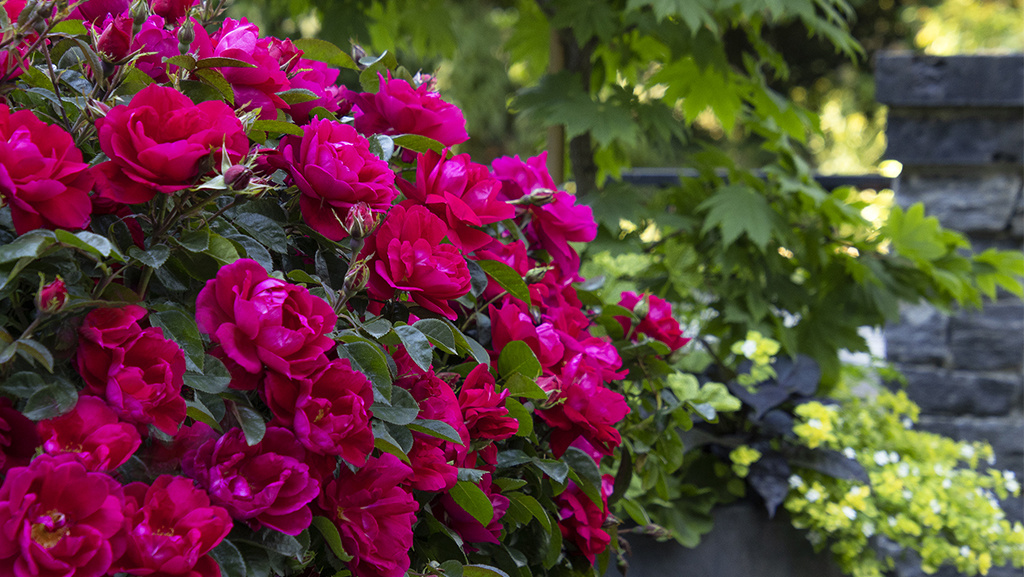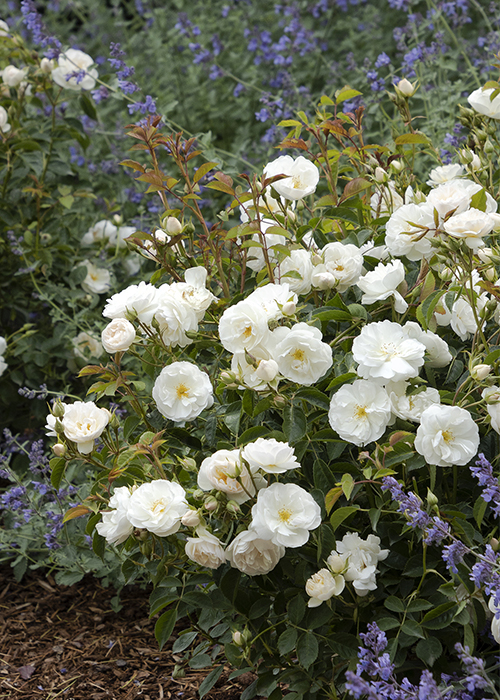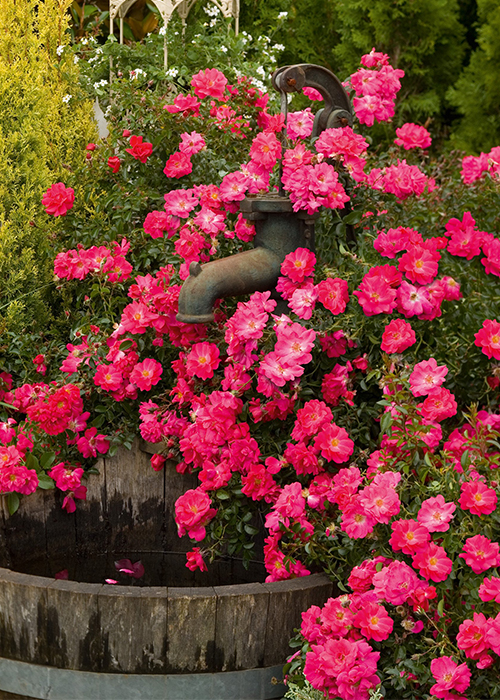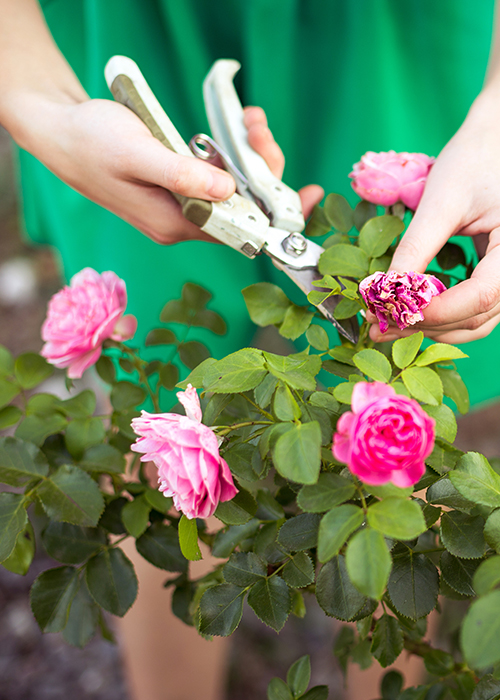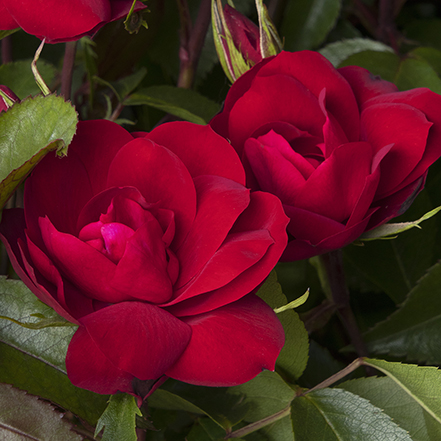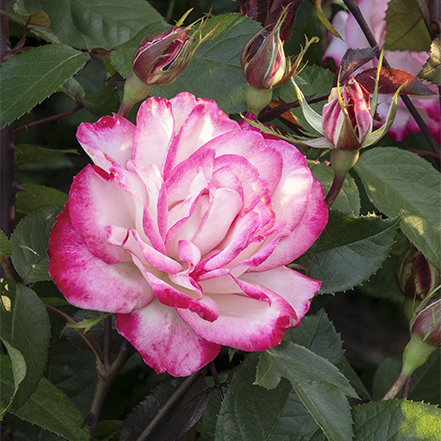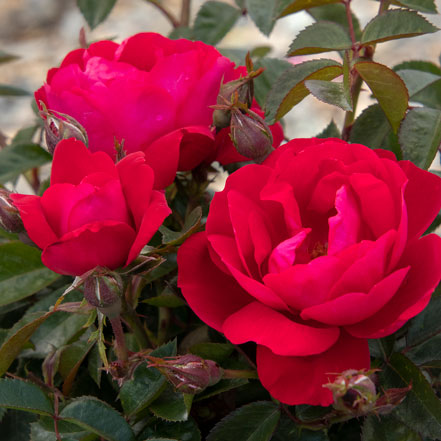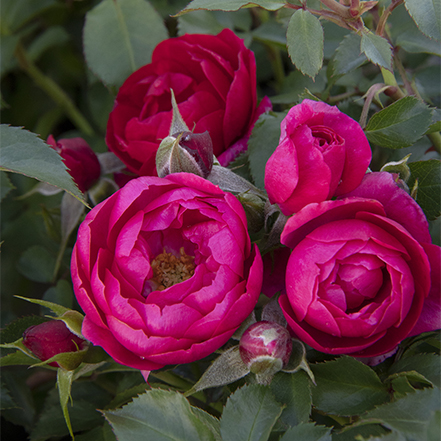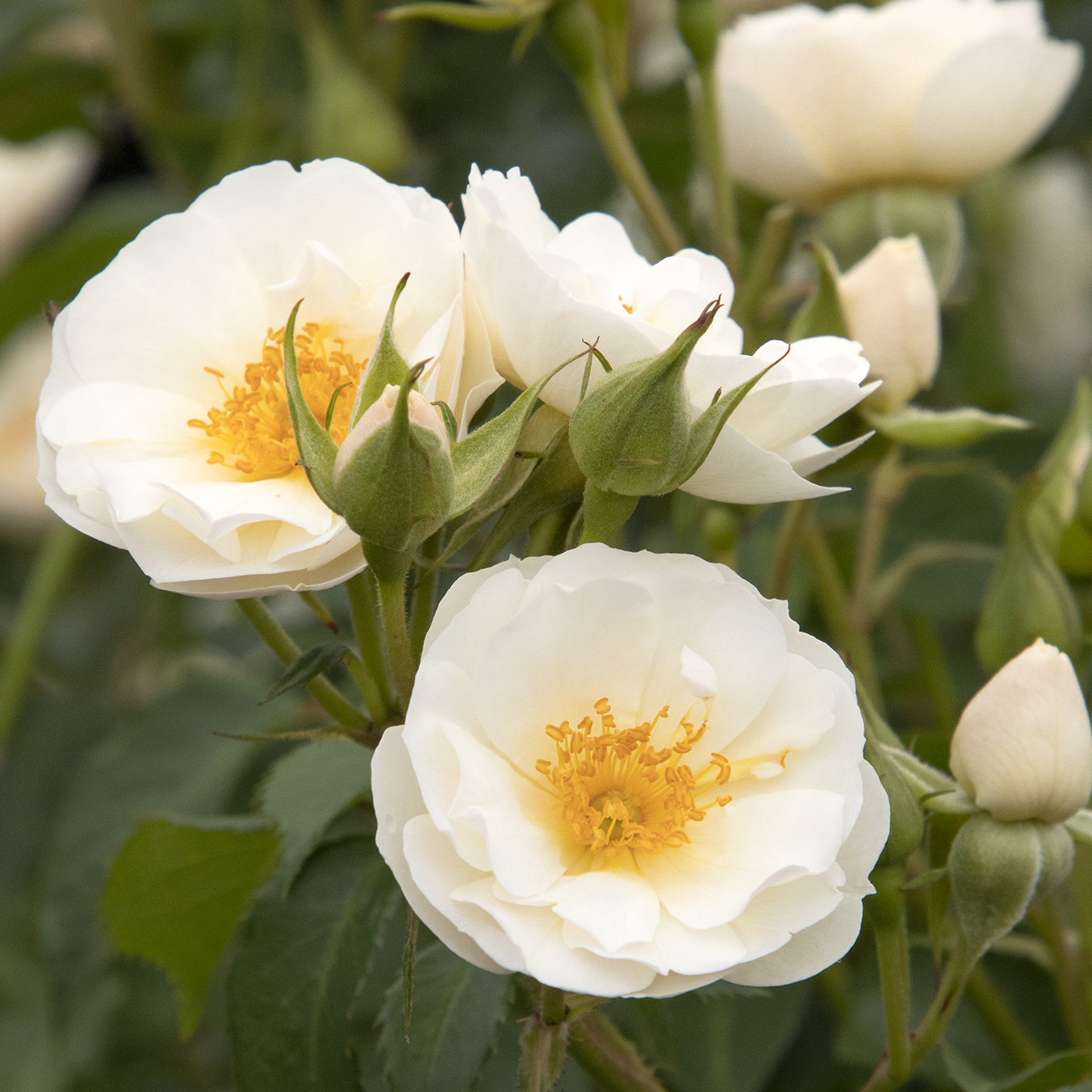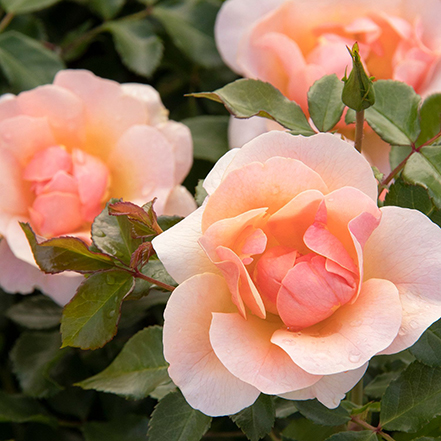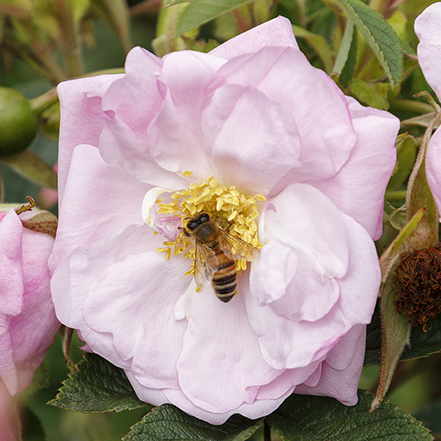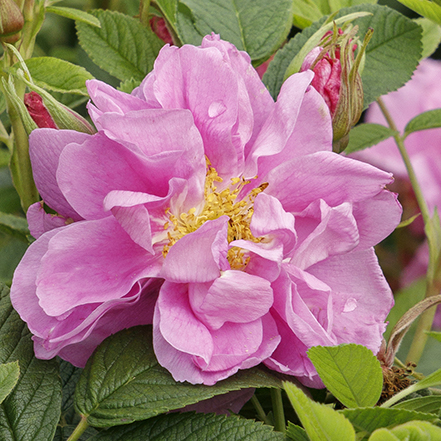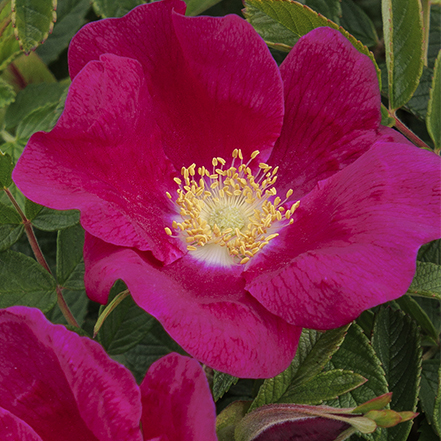The Rose: Queen of flowers. A timeless symbol of love, beauty, and bravery. If you would love to grow roses in your garden but lack the expertise to grow them successfully, fear no more. This rose care guide will give you the confidence to grow!
The following tips will give you the skills to enjoy today’s improved, easy-care varieties in your garden or containers.
To start off on the right foot, begin with selecting Monrovia roses that are suitable for your climate zone and site. Ultimately, the best roses for your garden will depend on your preference and your area's growing conditions. But know that there is a rose that will thrive in every hardiness zone.
Once you select the right rose for your conditions, then it's just a matter of giving them the simple care they require. Read on to get the details on how to do so.
Table of Contents:
1. Where and How to Plant Roses
- Rose Soil Needs
- Were to Plant Roses
- When to Plant Roses
- How to Plant Roses
2. How to Care for Roses
- How to Water Roses
- How to Fertilize Roses
- How to Prune Roses
- How to Care for Roses in Winter
3. Best Low-Maintenance, Disease-Resistant Roses
1. Where and How to Plant Roses
Rose Soil Needs
Before planting anything in the garden, consider the plant's soil needs. I call it the Goldilocks Growing Method, or the “just right” approach. And the first step is to test—just like our fairy tale heroine did.
However, this testing method is a professional soil test, not a taste one. Because without knowing the ph and nutrient levels of the soil, you won’t know what amendments are “just right” for the rose shrubs you want in your garden.
You can order a soil test through your extension service or local nursery and amend your soil accordingly.
Soil preparation and proper planting are essential for all garden plants to thrive with minimal fuss, and roses are no exception.
Whether you grow roses in the ground or a container, the “just right” pH is slightly acidic at 6.5. If the soil's pH is too high or too low, some nutrients may become unavailable for uptake by the plant roots.
Very few of us have the perfect soil, but luckily roses are adaptable, and all soil types can be improved with organic matter. The best options are compost, leaf mold, and composted cow manure. The other component of healthy soil is beneficial fungi or mycorrhizae; they act in a beneficial way to make moisture and nutrients available to the plant. Good news: every plant you see growing in a green Monrovia pot, including roses, will already have mycorrhizae in the soil.
Where to Plant Roses
Site your roses where they receive at least five to six hours of full sun with good drainage. In warmer, sunnier zones, roses will benefit from afternoon shade. Avoid planting too close to established trees and shrubs, as they will compete for water and nutrients with your roses.
When to Plant Roses
Roses can be planted during the growing season from early spring through fall. However, they should be in the ground at least six weeks before the first frost date in the fall to allow the shrub to establish a strong root system. In areas with dry summers, planting in fall is the best option, as it allows the roots to get established before the stress of heat begins.
Don’t plant in extreme weather conditions when the ground is frozen, water-logged, or during a drought.
How to Plant Roses
Planting a rose is much like planting any other shrub: be sure to dig the hole wide and deep enough to accept the plant's roots.
With roses, you need to ensure that the bud union—the base of the rose plant above the roots where the canes flare out—is about an inch above the soil level. The soil will settle over time, so avoid planting too deeply.
Once you have planted your rose, be sure to mulch. Mulching is recommended even if you’re planting in pots. It acts as an insulator, protecting the plant from temperature variations, helps to retain moisture, and can reduce weeds.
How Much Space Do Roses Need?
It depends on the variety that you are planting. Most roses will need between 2' and 5' of space. In the plant’s "overview" tab on Monrovia’s website, you will find the estimated mature size of the rose you’ve selected, then you can place your shrubs accordingly.
This means, to begin with, you may see gaps between the plants until the plants grow to maturity, which can take about three years.
2. How to Care for Roses
How to Water Roses
How often you water roses will depend on your garden's microclimate, which is the combined unique conditions of soil type, sunlight, temperature, wind, and precipitation throughout the seasons and the type of rose you are growing.
Generally, newly planted in-the-ground roses need more water than an established garden rose. Water slowly and deeply at ground level every two to three days to allow the shrub to grow the robust root system necessary for absorbing water and nutrients to support the growth of lush flowers and foliage.
Ideally, the soil surrounding the rose shrub should remain moist. Established roses should be watered once or twice weekly during dry periods.
Roses grown in containers dry out faster than those planted in the ground. Therefore, container roses may need to be watered daily, especially during hot weather. A larger container dries out slower and offers more room for the root system to grow. Because roses dislike standing water, choose containers that drain well.
Find our favorite roses for containers as well as tips for growing roses in containers here.
The “just-right” watering benefits are that well-watered roses are less stressed, are more disease resistant, and offer better blooms.
This Step-by-Step Guide offers in-depth information about caring for roses in the summer.
How to Fertilize Roses and Keep Them Healthy
When roses start to push new growth in the spring and you have removed any winter mulch, it's time to feed. Wait until new growth is about 2” long and leaves are starting to emerge.
The “just right” way to fertilize is to feed the soil and let the healthy soil feed the plants. Compost, composted manures, organic fertilizers, and alfalfa meal are slow-release fertilizers that nourish and improve soil quality.
Alfalfa is 5-1-2 (N-P-K, Nitrogen-Phosphorus-Potassium), providing a good nitrogen source, ALONG WITH calcium, iron, magnesium, phosphorous, zinc, vitamins (A, D, B1, B6, E, K, and U) and a fatty acid growth stimulant called triaconatol.
Apply an organic fertilizer that releases nutrients over time, followed by a layer of organic compost and the mulch, and voila! Your spring feeding is done.
Applying a time-release fertilizer will feed your plants for four to six months. (Check with your local independent garden center for commercially made organic products).
As the summer season progresses, inspect your plants for pests and diseases. If aphids are present, before spraying—even with an organic insecticidal soap—look for the presence of beneficial Ladybugs or Green Lacewings that will eat the aphids.
In hot, humid summers, powdery mildew may appear on the foliage. Remove and destroy affected leaves. It can be treated with an organic fungicide.
If you garden where Japanese Beetles are prevalent, be on the lookout. Neem oil and birds, like Purple Martins, keep them suppressed. Milky spore powder is a very effective method of controlling the larvae of Japanese Beetles, but it is a method that must be applied to lawns early in the larvae’s life cycle.
How to Prune Roses
Check your shrubs in early spring after the threat of frost has passed for signs of new growth—that’s the signal that it is time to prune. If you’re new to rose pruning, don’t worry about any lack of skill because, much like you when you get a bad haircut, roses will recover from over-pruning.
Now gather your gardening gloves* and pruners, and regardless of the type of rose you grow, keep the following pruning fundamentals in mind:
- Start with clean, sharp hand pruners, bypass loppers, or pruning saws—sanitize tools with rubbing alcohol before moving from one plant to another to prevent the spread of disease.
- Cut out all the dead wood, which won’t be green but gray, brown, or black, to the central cane or trunk.
- Remove all thin, weak canes smaller than a pencil in diameter.
- A basic pruning cut should be made at a 45-degree angle about ¼ inch above an outward-facing bud.
Monrovia’s repeat-blooming roses, like Grace ’N Grit™, Nitty Gritty™, and Seaside Swirl™, are fuss-free, and no pruning is required for continuous bloom. If pruning for size and shape, cut back the entire shrub by one-third in the spring. Prune any dead branches to ground level at any time.
Pruning climbing roses is more accessible when the rose is not in leaf, and pruning early promotes new growth. Cut old branches to the ground, retaining the younger, vigorous stems that can be secured to a support. Cutting flowers through the growing season will encourage reblooming.
For more traditional roses, the critical task of pruning is for the overall benefit of the plant. It triggers the growth of healthy new canes. while helping to control the size and shape, rejuvenating the plant, and encouraging blooming while increasing air circulation that wards off some diseases.
*Glove tip: The branches of a rose shrub are covered in thorns. Treat yourself to a long pair of tough, breathable, flexible gloves that protect your hands and forearms.
How to Care for Roses in Winter
Winter care begins in the fall if you live in Zones up to 6, where roses typically go dormant during the winter. In mid-to-late September, stop feeding and deadheading roses. Instead, allow the buds to turn into hips. Hips cause the plant to slow down its bloom frequency and stiffen its canes, which will help prepare the plant for dormancy in cold weather. In addition, the Rose hips provide a winter food source for fruit-eating birds and squirrels.
However, if you’ve planted the hardier, long-blooming roses like Seaside Swirl™, Nitty Gritty™, or Grace N’ Grit™ roses, apply an organic foliar spray, such as compost tea, at this time to encourage late fall blooming without pushing tender new growth.
While there are many reasons not to clean up the perennials in your garden—creating a haven for wildlife chief among them—your rose shrubs may require a conscientious fall clean-up.
Remove all the fallen leaves and debris to prevent the possible spread of fungal infections because even the best disease-resistant roses benefit from some basic steps to avoid rose pest damage and diseases in general. To suppress overwintering diseases on the shrub and ground, spray with an OMRI-rated dormant oil.
Watering during a dry fall is crucial in preparing it for winter. In addition, your roses may need supplemental watering throughout winter if it lacks snowfall or rain.
When the shrub starts to go dormant, surround the base of the plant with finely shredded mulch to protect the plant from freeze-thaw cycles. Mound the mulch around the base of the rose to a depth of 6-8 inches.
When preparing climbing roses for winter, tie the long canes to minimize wind damage. Wrapping canes in burlap with a covering of straw for insulation will help protect them from drying winds.
When choosing a rose for your garden, select varieties that will withstand the coldest winter temperatures in your garden. Use the Climate Zone feature on the My Plantfinder Tool to find hardy plants for your growing zone.
In zones 9-11, roses usually don’t go dormant. However, it is a good idea to ensure they are watered well. The moisture helps the plant tolerate fluctuating temperatures. Remove damaged foliage and clean up debris. Inspect your plants for pests or fungal problems that may develop. If necessary, apply an OMRI-rated horticultural oil at this time.
There you are, the basics to successfully growing your own roses, so courageous one, order the roses for your garden today. To paraphrase an inspirational Dale Carnegie quote:
"We all dream of some magical rose garden over the horizon instead of buying the roses that could be blooming in our gardens this summer."
3. Best Low-Maintenance, Disease-Resistant Roses
Grace N' Grit™ Shrub Roses
Grace N' Grit™ Roses are a Monrovia exclusive, own-root rose with outstanding disease resistance, and self-cleaning flowers. They have proven performance coast to coast in heat and humidity as well as dry, hot summers. They require very little care and require neither deadheading nor pruning. Upright bouquets of beautiful, double blooms on a fuss-free shrub. These will endure the trials of a long, hot summer with unwavering blooming zeal. The prolific, bold flowers and lush foliage make a dynamic hedge, barrier, or accent plant. Full sun. Up to 5' tall, 4' wide. Zones 4-9.
Nitty Gritty™ Groundcover Roses
Another Monrovia exclusive, this own-root rose is tough-as-nails and beautiful. Its easy-care nature makes it a great choice for groundcover, producing a profusion of beautiful blooms. With its exceptional disease resistance and self-cleaning habit, this rose is a hassle-free addition to any garden. Its double flowers provide stunning warm-season hues, blooming from late spring to early fall.
This low-maintenance rose is perfect for front borders, as accents, or interplanted as a colorful, low hedge. It also works well in containers. You can't go wrong with these easy-going roses. Full sun. Up to 3' tall, 4' wide. Zones 4-9.
Seaside Swirl™ Rugosa Roses
Terrific amount of blooms on a smaller, far more compact plant than other rugosas. Blooms from mid-spring into fall. This is a great, easy-care option for tough conditions with extra cold hardiness that maintains its beauty even when exposed to sea spray and road salt. Leaves turn gold in the fall. Full sun. Up to 3' tall and wide. Zones 3-9.
Learn More About Growing and Designing with Roses
- A Step-by-Step Guide to Caring for Your Roses in the Summer
- Best Roses for Containers
- Plant This Not That: Extraordinary Alternatives to Ordinary Plants
- Easy Beauty: Colorful low-maintenance plants for a beautiful garden
- Meet the Roses: The new and beautiful Grace N Grit™
- 5 Ways to Design with Roses
- Romancing the Roses: Fill your garden with these flowers
- For the Love of Roses: A look into America's favorite flower




